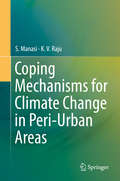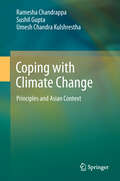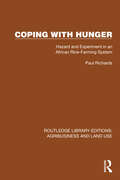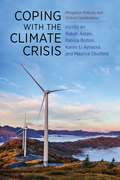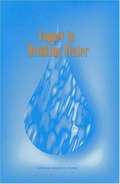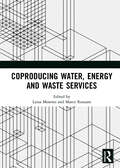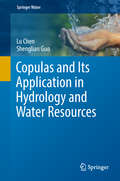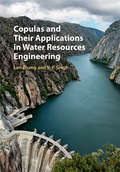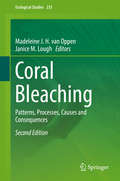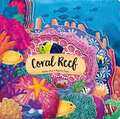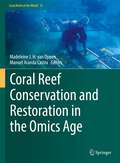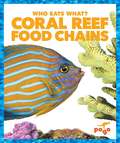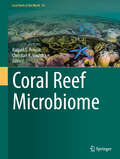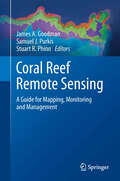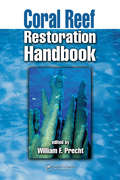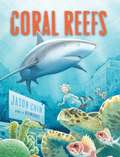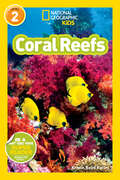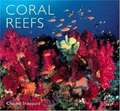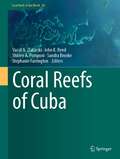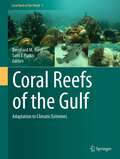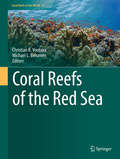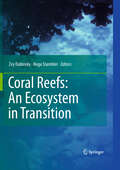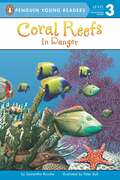- Table View
- List View
Coping Mechanisms for Climate Change in Peri-Urban Areas
by S. Manasi K. V. RajuThis book discusses the dynamics and resource management qualities of the peri-urban interface to address climate change consequences, focusing on the peri-urban region of the global city of Bengalaru. In 5 chapters, the authors document the unique challenges experienced in peri-urban areas, including soil-water vegetation dynamics, local and regional impacts on water bodies (surface and groundwater), food production issues, and the inhibited adaptive capacity of local communities. The book also provides knowledge on implementations of environmental management by local institutions, government interventions that have acted as catalysts in promoting community based adaptation strategies, and the physical, social and economic aspects of rural-urban dynamics. The book not only adds to the scarce existing literature on peri-urban contexts, but also addresses the role of culture in protecting ecological landscapes and how traditions play an important role in coping with climate change. Furthermore, the authors expand on these climate change coping mechanisms in peri-urban areas, taking into account local cultural factors and interesting governance interventions in the context of health. The book will be of interest to planners, policy makers, and students and researchers engaged in rural-urban dynamics and climate change adaptation.
Coping with Climate Change: Principles And Asian Context
by Ramesha Chandrappa Sushil Gupta Umesh Chandra KulshresthaThe Environmental and climatic issues varies from continent to continent and is unique to Asia. Understanding the issues does need lot of research and study material which students may not be able to gather due to shortage of time and resources. Hence an effort is made by authors gathering there experience and academic input from renowned universities of world. Climate change is real and coping with it is major concern in coming days. Most of the books written and sold in the past need updating and customizing. The general description of climate change and world will not help the professionals and students. It needs to seen area wise as a professional will work in specific geographic area. Hence an effort is made to collect data from Asia which host most populated countries along with ecological hot spots.
Coping with Hunger: Hazard and Experiment in an African Rice-Farming System (Routledge Library Editions: Agribusiness and Land Use #22)
by Paul RichardsOriginally published in 1986, Coping with Hunger demonstrates that effective agricultural development in resource-poor regions must be based in a respect for the indigenous farmer’s understanding of the environment. Based on participant-observation of rice farming in Sierra Leone, the book challenges the prevailing of attitudes of policy makers in the late 20th Century and restores indigenous culture and local wisdom to their rightful place. After analysing the fate of a number of ‘top-down ‘attempts to improve rice cultivation in Sierra-Leone the author derives an alternative agenda of research and development issues more closely reflecting the resource-poor farmers’ major interests and priorities. As a significant research-based contribution to the widespread general debates about the relevance of social factors in technological change, this book will be of interest to students in social and environmental sciences.
Coping with the Climate Crisis: Mitigation Policies and Global Coordination
by Patrick Bolton Maurice Arezki Rabah El Aynaoui Karim ObstfeldReducing carbon emissions is the most complex political and economic problem humanity has ever confronted. Coping with the Climate Crisis brings together leading experts from academia and policy circles to explore issues related to the implementation of the COP21 Paris Agreement and the challenges of accelerating the transition toward sustainable development.The book synthesizes the key insights that emerge from the latest research in climate-change economics in an accessible and useful guide for policy makers and researchers. Contributors consider a wide range of issues, including the economic implications and realities of shifting away from fossil fuels, the role of financial markets in incentivizing development and construction of sustainable infrastructure, the challenges of evaluating the well-being of future generations, the risk associated with uncertainty surrounding the pace of climate change, and how to make climate agreements enforceable. They demonstrate the need for a carbon tax, considering the issues of efficiently pricing carbon as well as the role of supply-side policies on fossil fuels. Through a range of perspectives from academic economists and practitioners in the public and private sectors who work either at the country level or under the auspices of multilateral organizations, Coping with the Climate Crisis outlines what it will take to achieve a viable, global climate-stabilization path.
Copper in Drinking Water
by Committee On Copper In Drinking WaterThe safety of the nation's drinking water must be maintained to ensure the health of the public. The U.S. Environmental Protection Agency (EPA) is responsible for regulating the levels of substances in the drinking water supply. Copper can leach into drinking water from the pipes in the distribution system, and the allowable levels are regulated by the EPA. The regulation of copper, however, is complicated by the fact that it is both necessary to the normal functioning of the body and toxic to the body at too high a level.The National Research Council was requested to form a committee to review the scientific validity of the EPA's maximum contaminant level goal for copper in drinking water. Copper in Drinking Water outlines the findings of the committee's review. The book provides a review of the toxicity of copper as well as a discussion of the essential nature of this metal. The risks posed by both short-term and long-term exposure to copper are characterized, and the implications for public health are discussed. This book is a valuable reference for individuals involved in the regulation of water supplies and individuals interested in issues surrounding this metal.
Coproducing Water, Energy and Waste Services
by Luisa Moretto and Marco RanzatoConventional services, such as water, energy and waste services, have been for a long time physically networked and centrally managed. Today, this delivery model appears increasingly inefficient in two respects. It often fails in guaranteeing its financial viability and equitable service access, and and it generally draws heavily on the natural resources conveyed by these services. The book aims thus at exploring how service coproduction, based on public-community collaborations, can represent a valuable alternative to the conventional service provision model. Contributions in this book look into service coproduction and its relationship with the conventional service model both in the Global North (Germany) and Global South (Bolivia, Brazil, Colombia, India, Tanzania). They also address a variety of different perspectives in coproducing conventional services, such as the role of service modernisation, the variety of non-networked solutions, the relationship with the commons, just to cite some of them. Eventually, this book provides a first comprehensive exploration of the service coproduction theory in relation to conventional services, such as water, energy and waste. The chapters originally published as a special issue in Urban Research & Practice.
Copulas and Its Application in Hydrology and Water Resources (Springer Water)
by Lu Chen Shenglian GuoThis book presents an overview of copula theory and its application in hydrology, and provides valuable insights, useful methods and practical applications for multivariate hydrological analysis using copulas. In addition, it extends the traditional bivariate model to trivariate or multivariate models. The specific applications covered include the study of flood frequency analysis, drought frequency analysis, dependence analysis, flood coincidence risk analysis and statistical simulation using copulas. The book offers a valuable guide for researchers, scientists and engineers working in hydrology and water resources, and will also benefit graduate or doctoral students with a basic grasp of copula functions who want to learn about the latest research developments in the field.
Copulas and their Applications in Water Resources Engineering
by Lan Zhang V. P. SinghComplex environmental and hydrological processes are characterized by more than one correlated random variable. These events are multivariate and their treatment requires multivariate frequency analysis. Traditional analysis methods are, however, too restrictive and do not apply in many cases. Recent years have therefore witnessed numerous applications of copulas to multivariate hydrologic frequency analyses. This book describes the basic concepts of copulas, and outlines current trends and developments in copula methodology and applications. It includes an accessible discussion of the methods alongside simple step-by-step sample calculations. Detailed case studies with real-world data are included, and are organized based on applications, such as flood frequency analysis and water quality analysis. Illustrating how to apply the copula method to multivariate frequency analysis, engineering design, and risk and uncertainty analysis, this book is ideal for researchers, professionals and graduate students in hydrology and water resources engineering.
Coral Bleaching: Patterns, Processes, Causes and Consequences (Ecological Studies #233)
by Madeleine J. van Oppen Janice M. LoughOne of the most serious consequences of global climate change for coral reefs is the increased frequency and severity of mass coral bleaching events and, since the first edition of this volume was published in 2009, there have been additional mass coral bleaching events. This book provides comprehensive information on the causes and consequences of coral bleaching for coral reef ecosystems, from the genes and microbes involved in the bleaching response, to individual coral colonies and whole reef systems. It presents detailed analyses of how coral bleaching can be detected and quantified and reviews future scenarios based on modeling efforts and the potential mechanisms of acclimatisation and adaptation. It also briefly discusses emerging research areas that focus on the development of innovative interventions aiming to increase coral climate resilience and restore reefs.
Coral Reef
by Martin Šodjr Radka PíroDive into the ocean, explore the colorful coral reef, and learn about the sea animals who call it home in this amazing picture book.The ocean is a magical place with so much to see. So, grab your snorkel and swim around a beautiful coral reef where you&’ll discover all the amazing sea creatures who live there! From hermit crabs, fish, and eels to sea horses, octopuses, dolphins, and so much more, this picture book lets you peek inside while learning tons of fun facts about these stunning animals and their lives inside a coral reef.&“Engaging, informative, and best of all—fun!&” —Cheryl Butler, host of The Mighty Mommy podcastThis is a fixed-format ebook, which preserves the design and layout of the original print book
Coral Reef Conservation and Restoration in the Omics Age (Coral Reefs of the World #15)
by Madeleine J. H. van Oppen Manuel Aranda LastraThe rapid demise of coral reefs worldwide has spurred efforts to develop innovative conservation and restoration methods. Many of these rely on omics approaches to produce genetic, genomic, transcriptomic, epigenomic or metabolomic data to inform conservation and restoration interventions. This book provides the state of play of this field. It discusses topics ranging from how genomic and environmental DNA (eDNA) data can be used to inform marine protected area design and cryopreservation strategies, the use of knowledge on adaptive genetic and epigenetic variation to maximise environmental stress tolerance of coral stock, harnessing transcriptome data to develop early warning markers, the use of microbial symbiont omics data in guiding restoration strategies, to applications of metabolomics and genetic engineering. How best to translate omics data to resource managers is also discussed.
Coral Reef Food Chains (Who Eats What?)
by R. J. BaileyIn Coral Reef Food Chains, early fluent readers explore the coral reef biome and the food chains it supports. Vibrant, full-color photos and carefully leveled text engage young readers as they explore how energy flows through plants and animals on a coral reef.
Coral Reef Microbiome (Coral Reefs of the World #20)
by Christian R. Voolstra Raquel S. PeixotoMicroorganisms, the catalysts of all biogeochemical cycles on Earth, are the origin and essence of life—an invisible yet powerful force sustaining all living organisms. The health of both individual organisms and ecosystems critically depends on functional microbiomes that drive essential processes such as nutrient cycling, pathogen control, detoxification, and resilience. However, like their macroorganism counterparts, these beneficial microbes are vulnerable to environmental changes, and their decline often accelerates ecosystem degradation. Anthropogenic impacts have profoundly altered and often degraded most ecosystems and their microbiomes, with coral reefs being no exception. Stony corals, the foundation of these vibrant ecosystems, are among the most threatened marine organisms. Shifts in coral microbiomes toward dysbiotic (harmful) assemblages are increasingly recognized as both a cause and consequence of coral mortality. In response, active intervention strategies are being developed to restore and rehabilitate degraded microbiomes, aiming to restore and re-establish the beneficial microbial communities that sustain the health of both their host organisms and ecosystems. The success of these approaches depends on our understanding of the distribution, ecological roles, and interactions between corals and their associated microbiomes, as well as how environmental factors influence them and their potential to either amplify or mitigate anthropogenic impacts. This book delves into these topics, examining how they shape coral holobiont assemblages and offer pathways for active intervention. In addition, this book provides a practical, tailored, and adaptable roadmap for stakeholders to integrate the latest insights into a broader One Health framework and ecosystem perspective.
Coral Reef Remote Sensing: A Guide for Mapping, Monitoring and Management
by James A. Goodman Samuel J. Purkis Stuart R. PhinnRemote sensing stands as the defining technology in our ability to monitor coral reefs, as well as their biophysical properties and associated processes, at regional to global scales. With overwhelming evidence that much of Earth's reefs are in decline, our need for large-scale, repeatable assessments of reefs has never been so great. Fortunately, the last two decades have seen a rapid expansion in the ability for remote sensing to map and monitor the coral reef ecosystem, its overlying water column, and surrounding environment. Remote sensing is now a fundamental tool for the mapping, monitoring and management of coral reef ecosystems. Remote sensing offers repeatable, quantitative assessments of habitat and environmental characteristics over spatially extensive areas. As the multi-disciplinary field of coral reef remote sensing continues to mature, results demonstrate that the techniques and capabilities continue to improve. New developments allow reef assessments and mapping to be performed with higher accuracy, across greater spatial areas, and with greater temporal frequency. The increased level of information that remote sensing now makes available also allows more complex scientific questions to be addressed. As defined for this book, remote sensing includes the vast array of geospatial data collected from land, water, ship, airborne and satellite platforms. The book is organized by technology, including: visible and infrared sensing using photographic, multispectral and hyperspectral instruments; active sensing using light detection and ranging (LiDAR); acoustic sensing using ship, autonomous underwater vehicle (AUV) and in-water platforms; and thermal and radar instruments. Emphasis and Audience This book serves multiple roles. It offers an overview of the current state-of-the-art technologies for reef mapping, provides detailed technical information for coral reef remote sensing specialists, imparts insight on the scientific questions that can be tackled using this technology, and also includes a foundation for those new to reef remote sensing. The individual sections of the book include introductory overviews of four main types of remotely sensed data used to study coral reefs, followed by specific examples demonstrating practical applications of the different technologies being discussed. Guidelines for selecting the most appropriate sensor for particular applications are provided, including an overview of how to utilize remote sensing data as an effective tool in science and management. The text is richly illustrated with examples of each sensing technology applied to a range of scientific, monitoring and management questions in reefs around the world. As such, the book is broadly accessible to a general audience, as well as students, managers, remote sensing specialists and anyone else working with coral reef ecosystems.
Coral Reef Restoration Handbook
by William F. Precht" this book is the first to describe, in detail, the art and science of coral reef restoration. It is to be hoped that the information that can be gleaned within the pages of this book will set a path towards continued preservation of this valuable underwater treasure to be used, appreciated, and experienced for future generations."-- Senator
Coral Reefs
by Jason ChinVenture to the depths of the coral reefs in an exploration of the true and truly wild in this follow-up to the stellar Redwoods. During an ordinary visit to the library, a girl pulls a not-so-ordinary book from the shelves. As she turns the pages in this book about coral reefs, the city around her slips away and she finds herself surrounded by the coral cities of the sea and the mysterious plants and animals that live, hunt, and hide there. Image descriptions present.
Coral Reefs
by Seymour SimonSeymour Simon knows how to explain science to kids and make it fun. He was a teacher for more than twenty years, has written more than 250 books, and has won multiple awards. <P><P>In Coral Reefs, Simon introduces elementary-school readers to the oceans’ reefs through wonderful descriptions and stunning full-color photographs. He encourages appreciation of the ecology of coral reefs, explains why they are in danger, and suggests ways kids can help save the endangered reefs. Lexile Measure: NC1110L
Coral Reefs (Readers)
by Kristin Baird RattiniIn this level 2 reader, young readers explore the amazing underwater world of coral reefs. Beautiful photos and carefully leveled text make this book perfect for reading aloud and for independent reading.
Coral Reefs (WorldLife Library)
by Charles SheppardCoral reefs are one of the wonders of the natural world. Protecting thousands of miles of shoreline from erosion, these intricate structures support biodiversity essential to the balance of the world's ecosystems. They are one of nature's most significant and ancient infrastructures. Global warming and our overuse of the reefs is causing untold damage to these beautiful yet fragile formations. In this lavishly illustrated book, Dr. Charles Sheppard explores the underwater world of coral reefs. Using popular examples from around the world, he explains how these vast constructs function and what must be done to save them.
Coral Reefs of Cuba (Coral Reefs of the World #18)
by Vassil N. Zlatarski John K. Reed Shirley A. Pomponi Sandra Brooke Stephanie FarringtonThis comprehensive volume gathers foremost experts on the coral reefs of Cuba who represent a spectrum of disciplines, including biology, conservation ecology, economics and geology. The volume is organized along general themes including the Cuban Reef biota, reefs occurring in the Mesophotic and Eutrophic zones, ecology, conservation, management and the economic importance of the coral reefs of Cuba. The combination of case studies, new and previously published research, historical overview and examples of the ways in which research has contributed to the management and conservation of Cuban coastal resources provides a unique reference for graduate students and professionals holding a wide range of interests and expertise related to coral reef systems.
Coral Reefs of the Gulf: Adaptation to Climatic Extremes (Coral Reefs of the World #3)
by Sam J. Purkis Bernhard M. RieglCoral Reefs of the Gulf: Adaptation to Climatic Extremes is a complete review and reference for scientists, engineers and students concerned with the geology, biology or engineering aspects of coral reefs in the Middle East. It provides for the first time a complete review of both the geology and biology of all extant coral areas in the Gulf, the water body between Iran and the Arabian Peninsula. In summer, this area is the hottest sea with abundant coral growth on earth and already today exhibits a temperature that is predicted to occur across the topical ocean in 2100. Thus, by studying the Gulf today, much can be learned about tomorrow's world and the capability of coral reefs to adapt to climatic extremes. This volume provides the most authoritative and up-to-date review of the coral reefs in the Gulf. It can be used as a volume of general reference or as a textbook treating recent coral reefs. Written by local and international experts, the text is richly illustrated and will remain a standard reference for the region for decades to come. Contributions stretch from climatology through geology, biology, ecological modelling and fisheries science to practical conservation aspects. The book is useful for the technical expert and casual reader alike.
Coral Reefs of the Red Sea (Coral Reefs of the World #11)
by Christian R. Voolstra Michael L. BerumenThis volume is a complete review and reference work for scientists, engineers, and students concerned with coral reefs in the Red Sea. It provides an up-to-date review on the geology, ecology, and physiology of coral reef ecosystems in the Red Sea, including data from most recent molecular studies. The Red Sea harbours a set of unique ecological characteristics, such as high temperature, high alkalinity, and high salinity, in a quasi-isolated environment. This makes it a perfect laboratory to study and understand adaptation in regard to the impact of climate change on marine ecosystems. This book can be used as a general reference, guide, or textbook.
Coral Reefs of the United Kingdom Overseas Territories (Coral Reefs of the World)
by Charles R.C. SheppardThe tropical UK Territories have extensive coral reefs. Huge parts of these areas are exceptionally rich, productive and diverse. Their marine biodiversity exceeds that of the UK itself, and several are already, or are planned to be, strictly protected. Some of these areas serve as reference sites for many other countries with damaged reefs and they are oases of tropical marine biodiversity in a fast-degrading world. This book reviews all of the UK reefs, from those scarcely known to those where substantial research has already been performed.
Coral Reefs: An Ecosystem In Transition
by Zvy Dubinsky Noga StamblerThis book covers in one volume materials scattered in hundreds of research articles, in most cases focusing on specialized aspects of coral biology. In addition to the latest developments in coral evolution and physiology, it presents chapters devoted to novel frontiers in coral reef research. These include the molecular biology of corals and their symbiotic algae, remote sensing of reef systems, ecology of coral disease spread, effects of various scenarios of global climate change, ocean acidification effects of increasing CO2 levels on coral calcification, and damaged coral reef remediation. Beyond extensive coverage of the above aspects, key issues regarding the coral organism and the reef ecosystem such as calcification, reproduction, modeling, algae, reef invertebrates, competition and fish are re-evaluated in the light of new research and emerging insights. In all chapters novel theories as well as challenges to established paradigms are introduced, evaluated and discussed. This volume is indispensible for all those involved in coral reef management and conservation.
Coral Reefs: In Danger (Penguin Young Readers, Level 3)
by Samantha BrookeDid you know that coral is actually a living creature? That the world's most famous coral reef, the Great Barrier Reef, is so big that astronauts can see it from outer space? Kids will love learning fun facts about coral reefs, the beautiful fish who make it their home, and why these amazing habitats are in danger.
